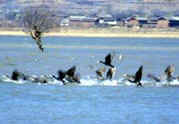Common Cormorant
(Phalacrocorax carbo)
Habitat: rivers, lakes, reservoirs and bays.
Feeding habits: dive quickly in water and catch fish with its bill.
Food: fish.
Size: with a full length of 80 cm; weight: 1700-2700 g.
 Habits:
it's a kind of migrant bird. It catches fish alone or in groups in water. There are webs in-between its toes and the bird is good at swimming and diving. It often airs its feather under the sun when it rests on the ground or trees after it eats to its full. It produces in North and Middle China and spends winter in districts in the South of the Yangzi River. Common cormorants live in groups and produce together. There are large amount of common cormorants reside and produce their babies on the Bird Island of Qinghai Lake. More than 10000 common cormorants will spend their winter in Mipu Natural Reserves of Hong Kong each year. Common cormorants seldom cry; but at the time when any disputes are raised in seeking a better place to rest, they would cry. Habits:
it's a kind of migrant bird. It catches fish alone or in groups in water. There are webs in-between its toes and the bird is good at swimming and diving. It often airs its feather under the sun when it rests on the ground or trees after it eats to its full. It produces in North and Middle China and spends winter in districts in the South of the Yangzi River. Common cormorants live in groups and produce together. There are large amount of common cormorants reside and produce their babies on the Bird Island of Qinghai Lake. More than 10000 common cormorants will spend their winter in Mipu Natural Reserves of Hong Kong each year. Common cormorants seldom cry; but at the time when any disputes are raised in seeking a better place to rest, they would cry.
Because they are quite skillful in catching fish, common cormorants are trained to catch fish for people since ancient time. At the present, fishermen in Yunnan, Guangxi, Hunan and elsewhere are still training common cormorants to catch fish for them.
Category: Ave, Pelecaniformes, Phalacrocoracidae
Distribution: All over Yunnan and most places of China.
 
|